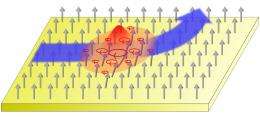When old is new again: Hall effect associated with electrons also occurs in non-charged particles

(PhysOrg.com) -- Just as electronics revolutionized computing and communications technology, spintronics is touted to follow suit. This relatively new field involves manipulating the flow of a magnetism-related property called 'spin'. In magnons, a spintronic counterpart of electrons, Naoto Nagaosa from the RIKEN Advanced Science Institute in Wako, Japan, and his colleagues have observed an effect first seen with electrons over 130 years ago: the Hall effect. The Hall effect is used in sensitive detectors, so the researchers believe their finding could lead to new applications for magnetic insulators.
The Hall effect arises because a charge-carrying particle such as an electron experiences a force perpendicular to its direction of motion as it moves through a magnetic field of a conducting material. The result is a build-up of charges of opposite signs on either side of the material, which creates a measureable electric field. Magnons, however, have no charge, so an analogous effect had never been observed previously.
“The Hall effect is one of the most fundamental phenomena in condensed matter physics,” explains Nagaosa. “It is important to study to what extent we can apply ideas from conventional electronics to spintronics.” Nagaosa, along with Yoshinori Tokura also from ASI, Yoshinori Onose and co-workers from The University of Tokyo, and Hosho Katsura from the University of California, Santa Barbara, USA, studied the magnetic and thermal properties of the insulating ferromagnet Lu2V2O7 at low temperatures. Rather than the electric field associated with the conventional effect, the Hall effect manifested in this material as a thermal conductivity gradient across the sample (Fig. 1). This difference occurs because the magnons carry heat, rather than charge.
The researchers showed that the size of the effect is not proportional to the applied magnetic field, but has a maximum at relatively low fields. This supports the hypothesis that magnons, influenced by the relativistic interaction, are responsible because the number of magnons is known to be reduced at these low-level magnetic fields. They also observed that the conductivity gradient started to decrease at higher fields. This observation allowed Nagaosa and colleagues to rule out lattice vibrations, or phonons, as another possible underlying cause of the experimental results: a phonon-induced thermal conductivity gradient would be expected to continue to increase with magnetic field.
“According to our theoretical prediction, only certain types of the crystal structure show this magnon Hall effect,” says Nagaosa. “To confirm this theory, we next aim to check that the phenomenon is absent in more conventional structures such as a cubic lattice.”
More information: Onose, Y., Ideue, T., Katsura, H., Shiomi, Y., Nagaosa, N. & Tokura, Y. Observation of the magnon Hall effect. Science 329, 297–299 (2010) www.sciencemag.org/cgi/content/short/329/5989/297
Provided by RIKEN


















